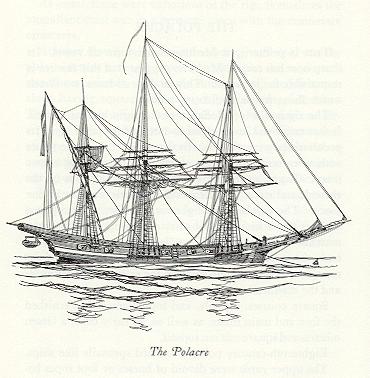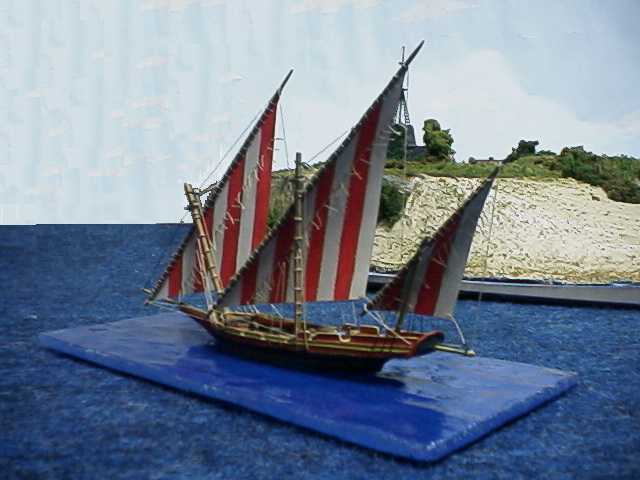


Beginnings
The xebec, as in most ship types, possesses origins difficult to trace. It probably began with the Mediterranean Galley, the type used by Italian city-states, Barbary Corsairs, and other Muslim empires since the middle ages. These ships had long, narrow hulls with a bank of oars. They were meant to be fast and manoueverable under oarpower. These ships also carried two or three lateen-rigged masts.
The foremast of the xebec was traditionally raked (bent) forward while the main was straight. There were no topmasts. The immense lateen yards were actually two spars lashed together at the thicker ends to form one. The hull had considerable overhang at the bow and stern. A ram was located at the bow, much above the waterline to form a prow. There was usually no bowsprit.
Although both galleys and xebecs were warships, some of the features of a xebec are also found in the Felucca, the Pink and the Polacre.
The Felucca is closer to the xebec than the galley. It was a smaller version of a galley, but still lateen rigged. In no way was a xebec ever bigger than a galley, so the felucca is a more likely anscestor.
The Pink and the Polacre are more likely derivatives of the xebec. The pink carried a similar rig, while retaining the rake in the foremast and the narrow beak. However, it possessed a characteristic stern to which it gave its name to. According to Culver, "the upper portion of the pink's stern was drawn out more or less behind the body of the vessel proper and usually terminated in a much restricted quadralateral transom." (152). The pink was more than anything amerchant ship so it had a more full hull and much less overhang at the bow and stern. At a glance, the xebec and the pink might be similar if it were not, at a closer inspection, for the unique shape of the xebec's hull.
In the late 18th century, there are accounts of xebec-frigates, ship-rigged ships with hulls similar to that of a xebec. Such designs can be yeilded to the name Polacre. These ships operated in the Mediterranean as frigates would anywhere in the world. They were owned by almost any nation with influence in the middle sea. They had three to four square sails on the main and fore masts, while the mizzen would have a large lateen sail. The hull otherwise was very similar to the xebec. The overhang, the prow, and the narrowness are all present.



From Galley to Xebec
The transition was very simple. During the 17th and 18th centuries, the Barbary pirates were a menace to Christian shipping, but if a Christian warship could come to blows with the galleys of the Muslim corsairs, the broadsides could eliminate the oar-driven vessels quickly.
One theory is that in order to be able to run away or even stand up to a fight, galleys needed to be upgraded. The result was a sailing ship with the capacity to carry guns. Rowers had to be removed to fit the guns, so the dependancy for speed in a corsair vessel fell to sail. To accomplish this, a hull similar to a galley, long and narrow, was used, but widened to achieve greater stability to mount guns. The graceful lines were maintained, and so a xebec is formed.
As seen below, the larger image is of a xebec's hull, while the inset image is of a galley. If the galley was widened and the oar-benches removed, a xebec is formed.

Rigs of the Xebec
The basic xebec carried three lateen-rigged masts, however, two other rigs were apparently used on the same xebec hull shape. A square-rigged mainmast appears on some western xebecs, as well as square sails on the mizzen. This would create the effect seen with the 'polacre' rig below. However, the fore and mizzen mast retained their rake.
The other rig that has been described is that of a fully-rigged ship, known as a xebec-frigate. This entails three square-rigged masts. This design, however, arguably becomes a true polacre.

|
The End of the Evolution
The most common form of xebec produced was the traditional lateen-rigged xebec. It had three lateen-rigged masts, the fore sail sometimes being bigger than the main. The formast was raked well to the bow while the mizzen was raked to the stern. The presence and size of a bowsprit depended on whether or not the xebec had a jib.
The hull was low and narrow, similar to a felucca. The bow retained a long prow and the stern was greatly extended with a grating over the narrow transom, if that was at all present. The unique shape of the hull allowed a small forecastle and an extended quarter deck. In some ships, the grated overhang at the stern would serve as a poop deck.

The xebec was mainly a warship, but came in many sizes depending on who built her and what their requirements were. It carried oars for auxillary power and manoueverability.
The Uses of a Xebec
Since the xebec was above all an excellent sailer, her speed could be used for commerce raiding, or piracy. And that it was. Corsairs, mainly out of Algiers, sailed in xebecs with up to 36 guns, and auxillary oars.
The Spanish used xebecs to fight the Algierian pirates with their own weapon, seeing that the Corsairs would run at first sight of a warship. The French and Italian city states probably adapted the design for the same purpose.
On the Atlantic, the British were already experimenting with different kinds of techniques, and there is no doubt they tested the value to the xebec's design. It is possible they had a fleet running out of Gibraltar containing xebecs.
The Operators of a Xebec
So far, there have been accounts of Barbary xebecs, as well as Spanish (jabeque), French (chebec), Italian (sciabecco), Russian (shebeck), and to some extents British xebecs (Dart and Arrow). It is interesting to note that the Danish (schierbek), Portuguese (xebeco), and Dutch (Schebeck) have the xebec in thier vocabulary too, denoting knowledge of the vessel. As well there are some records of xebecs operating on the Great Lakes and in North America during the American Revolution and the War of 1812 (Repulse and Champion). Further there is an account of 12 xebecs in the casualty list on the Danish side of the Bombardment of Copenhagan, 1801. Each mounted 4 guns. Otherwise, the majority of xebec operation appears to have occurred in the Mediterranean.